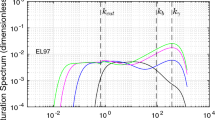Abstract
Based on gradient wind equations, including frictional force, and considering the effect of the movement of a tropical cyclone on wind speed, the Fujita Formula is improved and further simplified, and the numerical scheme for calculating the maximum wind speed radius and wind velocity distribution of a moving tropical cyclone is derived. In addition, the effect of frictional force on the internal structure of the tropical cyclone is discussed. By comparison with observational data, this numerical scheme demonstrates great advantages, i.e.: it can not only describe the asymmetrical wind speed distribution of a tropical cyclone reasonably, but can also calculate the maximum wind speed in each direction within the typhoon domain much more accurately. Furthermore, the combination of calculated and analyzed wind speed distributions by the scheme is perfectly consistent with observations.
Similar content being viewed by others
References
Chen, K., 1981: The typhoon pressure field and wind field models. Acta Oceanologica Sinica, 3(1), 44–55. (in Chinese)
Chen, K., and Z. Qin, 1989: The calculation of sea-level maximum wind speed of a typhoon. Acta Oceanologica Sinica, 11(1), 31–41. (in Chinese)
Chen, L., and Y. Ding, 1979: An Introduction to Typhoon over the West Pacific Ocean. Science Press, Beijing, 491pp. (in Chinese)
Chen, L., and Z. Luo, 1995: Effect of the interaction of different-scale vortices on the structure and motion of typhoon. Adv. Atmos. Sci., 12(2), 207–214.
Chen, L., and Z. Luo, 1998: Numerical study on function affecting tropical cyclone structure and motion. Acta Meteorologica Sinica, 12(4), 504–512.
Chen, L., X. Xu, Z. Luo, and J. Wang, 2002: Introduction to the Tropical Cyclone Dynamics. China Meteorological Press, Beijing, 317pp. (in Chinese)
China Meteorological Administration, Eds., 1987: Yearbook on Tropical Cyclones. China Meteorological Press, Beijing, 121pp. (in Chinese)
China Meteorological Administration, Eds., 1997: Yearbook on Tropical Cyclones. China Meteorological Press, Beijing, 105pp. (in Chinese)
China Meteorological Administration, Eds., 1991: Yearbook on Tropical Cyclones. China Meteorological Press, Beijing, 124pp. (in Chinese)
Fang, W., Q. Xu, J. Zhang, and C. Tan, 1987: Distribution of the wind speed in typhoon over the East China Sea Marine Forecasts, 4(3), 1–14. (in Chinese)
Hu, B., Y. Tan, and X. Zhang, 1999: Distribution of wind speed of tropical cyclone over the sea. Chinese J. Atmos. Sci., 23(3), 316–322. (in Chinese)
Kalnay, E., and Coauthors, 1996: The NCEP/NCAR 40-Year reanalysis project. Bull. Amer. Meteor. Soc., 77(3), 437–472.
Luo, Z., 1991: The possible causes for the counter clockwise loop routine of tropical cyclone. Chinese Science (B), 7, 769–775. (in Chinese)
Meng, Z., L. Chen, and X. Xu, 2002: Recent progress on tropical cyclone research in China. Adv. Atmos. Sci., 19(1), 103–110.
Shea, D. J., and W. M. Gray, 1973: The hurricane’s inner core region: I. Symmetric and asymmetric structure. J. Atmos. Sci., 30, 1544–1564.
Ueno, M., 1990: Causes and improvement of bias in tropical cyclone track forecast by JMA NWP models. ESCAP/WMO Typhoon Committee Annual Review, 123–133.
Wang, G., S. Wang, and J. Li, 1996: A typhoon bogus and its application to a movable nested mesh model. Journal of Tropical Meterology, 12(1), 9–17. (in Chinese)
Wang, X., 1986: The handling of pressure field and wind field in the numerical calculation of storm tides. Marine Forecasts, 3(4), 56–68. (in Chinese)
Wang, Y., 1998: On the bogusing of tropical cyclones in numerical models: The influence of vertical structure. Meteor. Atmos. Phys., 65, 153–170.
Wilson, B. L., 1956: Hurricane wave statistics for the Gulf of Mexico. U. S. Army Corps of Engineers, Beach Erosion Board, Technical Memorandum, 98.
Author information
Authors and Affiliations
Corresponding author
Rights and permissions
About this article
Cite this article
Hu, B., Yang, X., Ttan, Y. et al. A new method for calculating the wind speed distribution of a moving tropical cyclone. Adv. Atmos. Sci. 27, 69–79 (2010). https://doi.org/10.1007/s00376-009-7209-5
Received:
Revised:
Published:
Issue Date:
DOI: https://doi.org/10.1007/s00376-009-7209-5




